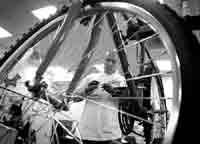Red Bike Program riding high in popularity
By MARTHA MARTINEZ
Anthony Galindo has his work cut out for him. It could take him anywhere
from five to six hours a day to do his job for the Red Bike Program at
Fresno State.

Psychology major Anthony Galindo works on a bicycle Monday for the Red Bike Program. Photo by Joseph Vasquez |
Galindo, a senior at Fresno State, is one of two repair people for the
program. On a busy day, he can repair more than six bicycles and depending
on the type of repair can spend up to an hour on each of the bicycles.
“There are days when you think you’ll have nothing to do,”
Galindo said. “Then by lunchtime, we have a lot of bicycles to repair.”
Repairs could be as benign as fixing a flat tire or as serious as having
to fix the gears on the bicycle, Galindo said.
Galindo has been working for the Red Bike Program since October 2003.
He said this semester is the busiest he has seen in regard to bicycle
repairs.
The reason for all the repairs is because “our older bikes are really
old,” he said.
The Red Bike Program, run by the department of parking and transportation,
started three years ago with about 55 bicycles and this semester a record
number of bicycles were rented, said Annette Harvey, director of commuter
services.
The bicycles that were used when the program started, which Galindo referred
to as the “older bikes,” are still being used.
The bicycles were not new to begin with. They were reconditioned and donated
to Fresno State by the Pleasant Valley State Prison in Coalinga.
The prison has donated bicycles to the school each semester since the
program was started. The 30 bicycles the prison donates each semester
are not enough to meet student demands and break down too quickly, Harvey
said.
In fall 2003, the Red Bike Program was not able to supply enough bicycles
for students for the first time in its operating history. About 100 students
were placed on a waiting list for the program, Harvey said.
“Demand was great, so we decided to go buy some,” she said.
With the money from parking citations, which is to be used for forms of
transportation other than driving, the commuter program purchased 200
bicycles.
The department of parking and transportation has a record of 320 rented
bicycles this semester, Harvey said. Some of those are still under the
original rent dates from when the program first got started in 2001, she
said.
“All that happens is they do not get their deposit back,”
Harvey said of students who have had their bicycles since 2001. Those
students receive phone calls from the transportation department telling
them to return the bicycles, Harvey said.
The $5-per-semester rental fee for a bicycle is what seems to attract
students. A refundable $15 deposit for an old bicycle and $50 for a new
bicycle is also required. A bicycle lock and helmet also come included
in the price. The bicycle must be returned at the end of the semester
for students to get their deposit back.
Harvey encourages students to join the program. She said with high gas
prices and the price of parking permits, students should be part of the
Red Bike Program.
Students who wish to rent a bicycle are not too late; 10 are still available
to rent this semester.
Graduate student Sunil Singh, who was on the waiting list in fall 2003,
finds it easier to ride a bicycle to school than to drive or walk.
He also rides to his job at the Save Mart Center.
“It was the cheap thing to do and I can go anywhere,” Singh
said.
Sandeepram Lakshmanan, who also enjoys the low cost of the program, not
only uses the bicycle for school, but also for errands such as grocery
shopping.
Low prices are not all students are attracted to. The repair services
the Red Bike Program offers are what attracted Arul Veluppillai to join;
although the low price did help, he said.
“They replace [the bicycle] if it is lost,” he said.
All three students live across the street from campus or within a short
walking distance. But they find it convenient to ride their bicycles.
Harvey said most students in the program live within a one-mile radius.
“Believe it or not,” she said, “people still ride their
cars.”
|

